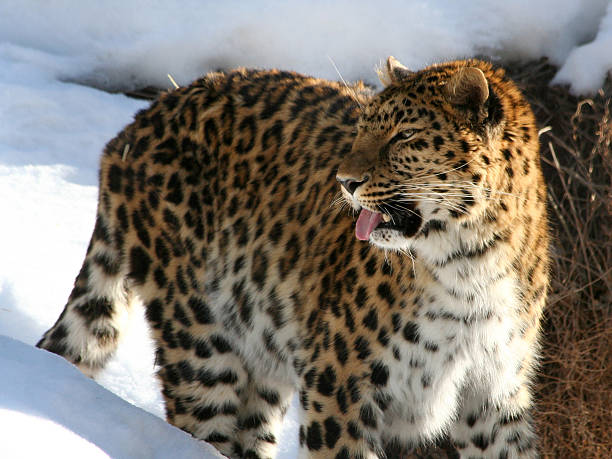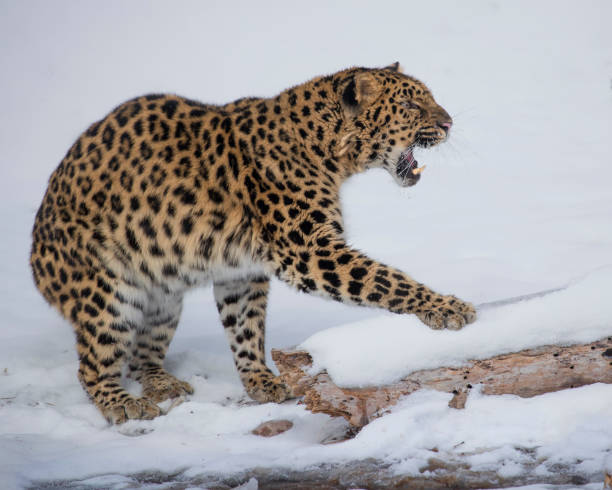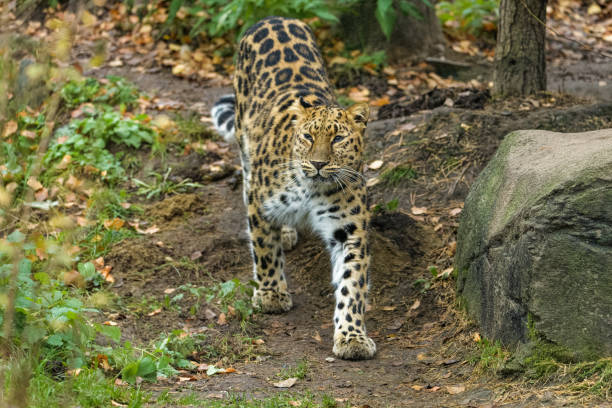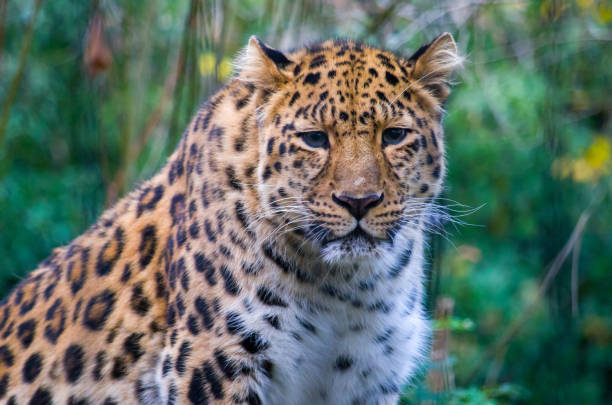Table of Contents
Scientific Classification
| Kingdom | Animalia |
| Phylum | Chordata |
| Class | Mammalia |
| Order | Carnivora |
| Family | Felidae |
| Genus | Panthera |
| Species | Panthera pardus orientalis |
| Scientific Name | Panthera pardus orientalis |
Description
The Amur leopard is among the rarest and most endangered big cats on the planet. It boasts a beautiful golden-yellow coat adorned with dark rosettes and spots, which aids in its camouflage within its natural environment. This magnificent feline can reach lengths of up to 4.5 feet, with a tail that can extend nearly 3 feet. Its sleek and agile physique is perfectly designed for stealth and speed. Males typically weigh between 70 and 110 lbs, while females are slightly smaller, averaging 55 to 95 lbs. Their thick fur, which can grow up to 2.5 inches long during winter, provides essential protection against harsh, frigid conditions.
Distribution
The range of leopards has significantly decreased. Although conservation efforts have increased, the wild leopard population remains critically low, making them one of the most endangered leopard species in the world.

Habitat
Amur leopards flourish in temperate forests characterized by mountainous terrain and rugged landscapes. They are well-adapted to extreme cold, in contrast to their African counterparts. During winter, temperatures can plummet to -30°F. These solitary felines prefer secluded areas. Dense vegetation, rocky regions, and river valleys provide perfect conditions for hunting and nurturing their cubs.
Diet
Amur leopards are opportunistic carnivores that hunt a diverse range of animals. Their main diet includes roe deer, sika deer, hares, wild boar, and small rodents. These leopards are adept hunters, able to take down prey that is significantly larger than they are. They rely on their keen eyesight and acute hearing to stealthily track their targets. Once close enough, they deliver a lethal bite to the neck. They often drag their kills into trees or dense bushes to protect them from scavengers such as tigers and bears.
Behavior
These elusive big cats mostly hunt at night. They prefer this time because their prey is most active then. They are solitary animals. Males and females meet only during mating season. Amur leopards create big territories. They mark these areas using scent glands and scratch trees. Their climbing skills let them navigate rocky ground and dodge dangers easily.

Lifespan
The challenges to their survival in the wild are numerous. Habitat destruction, poaching, and conflicts with humans all pose significant threats. Therefore, conservation efforts are crucial for ensuring their future.
Reproduction and Lifecycle
The mating season for Amur leopards typically takes place from late winter to early spring. Following a gestation period of around 90-105 days, females give birth to a litter that can range from 1 to 4 cubs. At birth, these cubs are blind and depend entirely on their mother for warmth, milk, and protection. They start to explore their environment after about two months and begin hunting when they reach around six months of age. The cubs remain with their mother for up to two years before leaving to establish their own territories.
Predators
Adult Amur leopards are at the top of the food chain and have few natural enemies. However, their cubs can be vulnerable to larger predators such as Siberian tigers and wolves. The greatest danger to their existence comes from humans, primarily due to habitat loss, poaching, and the illegal hunting of their prey.
Adaptations
Amur leopards possess a range of unique adaptations that enable them to thrive in their challenging habitat:
Thick fur: Offers insulation against severe cold.
Long legs: Enable efficient movement through deep snow.
Camouflaged coat: Assists in blending with their environment, making them nearly invisible to both prey and potential threats.
Strong jaws and sharp claws: Equip them to hunt large prey and defend their meals from scavengers.
Exceptional night vision: Aids in effective hunting during low-light conditions.
Conservation Status
The Amur leopard is critically endangered, according to the International Union for Conservation of Nature (IUCN). Recent estimates indicate that there are fewer than 120 individuals left in the wild. Conservation initiatives such as anti-poaching measures, habitat preservation, and breeding programs have contributed to stabilizing and slightly increasing their population. The World Wildlife Fund (WWF) is collaborating with Russian conservation groups to safeguard this remarkable species, with the goal of ensuring its survival for future generations.
The Amur leopard represents resilience and the beauty of the natural world. Its rarity and vulnerability make it a key focus for conservationists around the globe. To ensure that this magnificent big cat continues to roam the forests of the Russian Far East and beyond, we must protect its habitat and address threats like poaching and deforestation.



